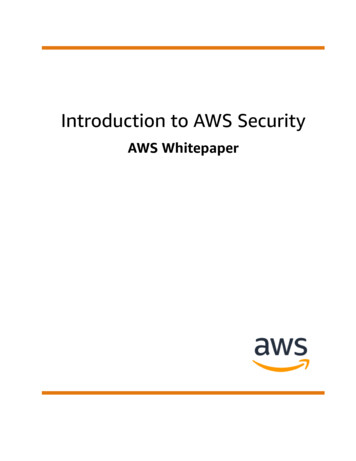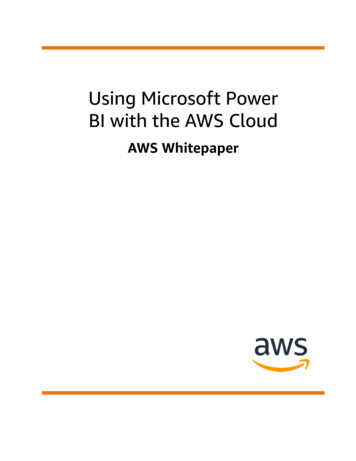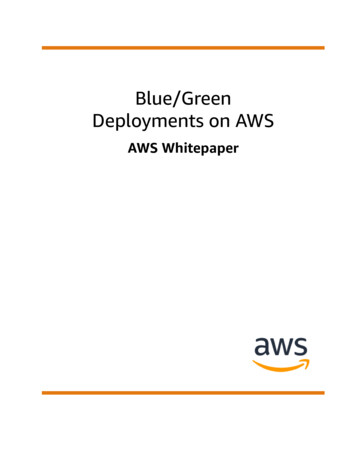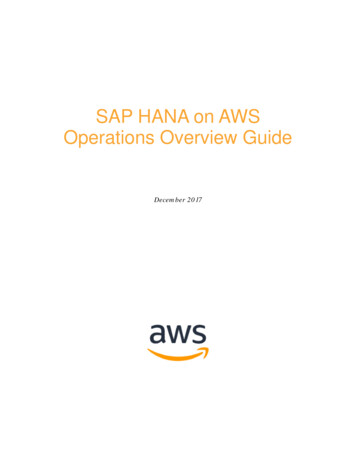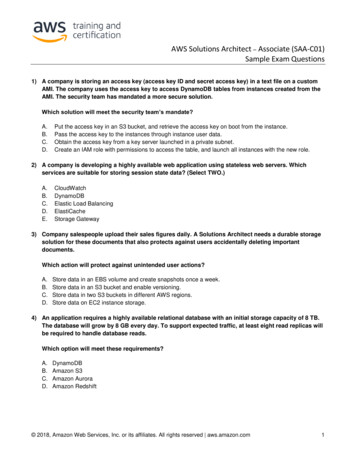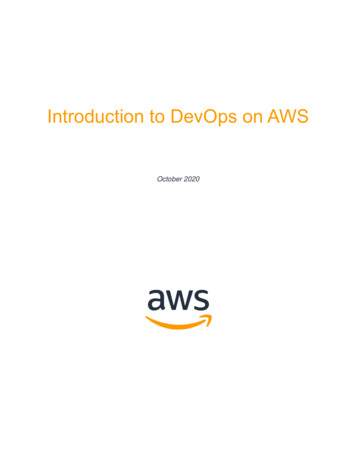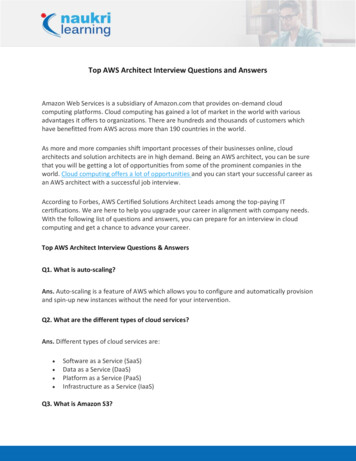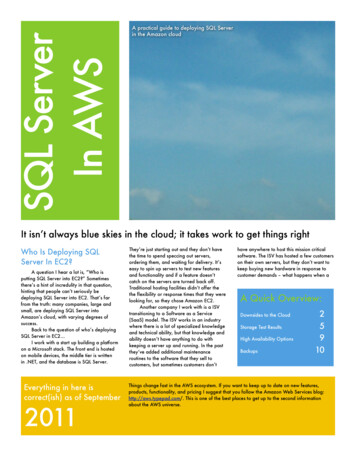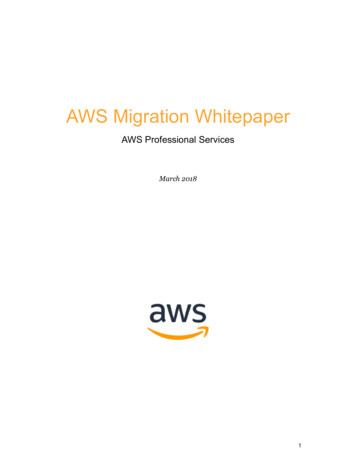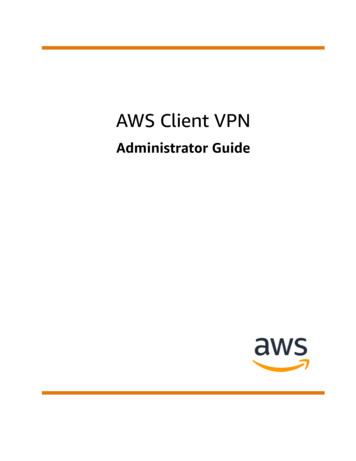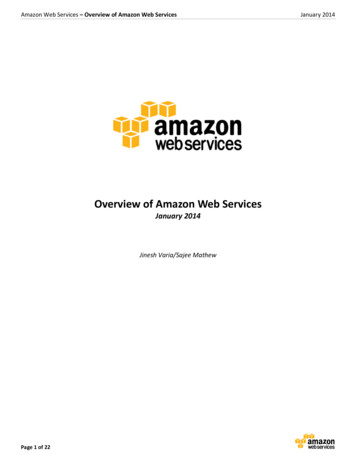
Transcription
Amazon Web Services – Overview of Amazon Web ServicesOverview of Amazon Web ServicesJanuary 2014Jinesh Varia/Sajee MathewPage 1 of 22January 2014
Overview of Amazon Web ServicesMarch 2013Table of ContentsTable of Contents . 2Introduction . 3What is “Cloud Computing”? . 3Amazon and Cloud Computing . 4The Differences that Distinguish AWS . 5Flexible . 5Cost-Effective . 6Scalable and Elastic . 7Secure. 7Experienced. 9Amazon Web Services Cloud Platform. 10Compute & Networking . 10Storage & Content Delivery Network . 12Database . 14Analytics . 16Application Services . 17Deployment and Management . 19Planning Your Next Steps . 22Getting Started With AWS . 22Page 2 of 22
Overview of Amazon Web ServicesMarch 2013IntroductionManaging the unique and groundbreaking changes in both technology and business over the past decade has created anongoing IT infrastructure challenge for many senior technology executives. Indeed, over the past ten years, the typicalbusiness application architecture has evolved from a desktop-centric installation, then to client/server solutions, andnow to loosely coupled web services and service-oriented architectures (SOA). Each evolutionary step has built on theprevious one while adding new challenges, dimensions, and opportunities for IT departments and their businesspartners.Recently, virtualization has become a widely accepted way to reduce operating costs and increase the reliability ofenterprise IT. In addition, grid computing makes a completely new class of analytics, data crunching, and businessintelligence tasks possible that were previously cost and time prohibitive. Along with these technology changes, thespeed of innovation and unprecedented acceleration in the introduction of new products has fundamentally changedthe way markets work. Along with the wide acceptance of software as a service (SaaS) offerings, these changes havepaved the way for the latest IT infrastructure challenge: cloud computing.What is “Cloud Computing”?Cloud computing has become one of the most discussed IT paradigms of recent years. It builds on many of the advancesin the IT industry over the past decade and presents significant opportunities for organizations to shorten time tomarket and reduce costs. With cloud computing, organizations can consume shared computing and storage resourcesrather than building, operating, and improving infrastructure on their own. The speed of change in markets createssignificant pressure on the enterprise IT infrastructure to adapt and deliver. Cloud computing provides fresh solutions toaddress these changes. As defined by Gartner1, “Cloud computing is a style of computing where scalable and elastic ITenabled capabilities are delivered as a service to external customers using Internet technologies.”Cloud computing enables organizations to obtain a flexible, secure, and cost-effective IT infrastructure, in much thesame way that national electric grids enable homes and organizations to plug into a centrally managed, efficient, andcost-effective energy source. When freed from creating their own electricity, organizations were able to focus on thecore competencies of their business and the needs of their customers. Likewise, cloud computing liberates organizationsfrom devoting precious people and budget to activities that don’t directly contribute to the bottom line while stillobtaining IT infrastructure capabilities.These capabilities include compute power, storage, databases, messaging, and other building block services that runbusiness applications. When coupled with a utility-style pricing and business model, cloud computing promises todeliver an enterprise-grade IT infrastructure in a reliable, timely, and cost-effective manner.1Gartner IT Glossary, .Page 3 of 22
Overview of Amazon Web ServicesMarch 2013To understand the impact and promise of cloud computing, one may first analyze the significance of and lessons learnedfrom business outsourcing. Focusing on a core competency and then shifting the peripheral business tasks to otherorganizations is a proven business strategy. Today, organizations outsource business functions such as logistics, humanresources (HR), payroll, and facilities. Many organizations have taken advantage of IT outsourcing as a way to movesome capabilities out of their internal organization altogether.Superficially, at least, cloud computing resembles the trend of business outsourcing because it provides the benefits ofleveraging the expertise of others and being cost efficient. However, cloud computing also provides flexibility, scalability,elasticity, and reliability. These additional benefits are why enterprise organizations see cloud computing as a powerfulnext step in their IT infrastructure evolution.Amazon and Cloud ComputingAmazon has a long history of using a decentralized IT infrastructure. This arrangement enabled our development teamsto access compute and storage resources on demand, and it has increased overall productivity and agility. By 2005,Amazon had spent over a decade and millions of dollars building and managing the large-scale, reliable, and efficient ITinfrastructure that powered one of the world’s largest online retail platforms. Amazon launched Amazon Web Services(AWS) so that other organizations could benefit from Amazon’s experience and investment in running a large-scaledistributed, transactional IT infrastructure. AWS has been operating since 2006, and today serves hundreds ofthousands of customers worldwide. Today Amazon.com runs a global web platform serving millions of customers andmanaging billions of dollars’ worth of commerce every year.Using AWS, you can requisition compute power, storage, and other services in minutes and have the flexibility to choosethe development platform or programming model that makes the most sense for the problems they’re trying to solve.You pay only for what you use, with no up-front expenses or long-term commitments, making AWS a cost-effective wayto deliver applications.Here are some of examples of how organizations, from research firms to large enterprises, use AWS today:A large enterprise quickly and economically deploys new internal applications, such as HR solutions, payrollapplications, inventory management solutions, and online training to its distributed workforce.An e-commerce website accommodates sudden demand for a “hot” product caused by viral buzz from Facebookand Twitter without having to upgrade its infrastructure.A pharmaceutical research firm executes large-scale simulations using computing power provided by AWS.Media companies serve unlimited video, music, and other media to their worldwide customer base.Page 4 of 22
Overview of Amazon Web ServicesMarch 2013The Differences that Distinguish AWSAWS is readily distinguished from other vendors in the traditional IT computing landscape because it is:Flexible. AWS enables organizations to use the programming models, operating systems, databases, andarchitectures with which they are already familiar. In addition, this flexibility helps organizations mix and matcharchitectures in order to serve their diverse business needs.Cost-effective. With AWS, organizations pay only for what they use, without up-front or long-termcommitments.Scalable and elastic. Organizations can quickly add and subtract AWS resources to their applications in order tomeet customer demand and manage costs.Secure. In order to provide end-to-end security and end-to-end privacy, AWS builds services in accordance withsecurity best practices, provides the appropriate security features in those services, and documents how to usethose features.Experienced. When using AWS, organizations can leverage Amazon’s more than fifteen years of experiencedelivering large-scale, global infrastructure in a reliable, secure fashion.FlexibleThe first key difference between AWS and other IT models is flexibility. Using traditional models to deliver IT solutionsoften requires large investments in new architectures, programming languages, and operating systems. Although theseinvestments are valuable, the time that it takes to adapt to new technologies can also slow down your business andprevent you from quickly responding to changing markets and opportunities. When the opportunity to innovate arises,you want to be able to move quickly and not always have to support legacy infrastructure and applications or deal withprotracted procurement processes.In contrast, the flexibility of AWS allows you to keep the programming models, languages, and operating systems thatyou are already using or choose others that are better suited for their project. You don’t have to learn new skills.Flexibility means that migrating legacy applications to the cloud is easy and cost-effective. Instead of re-writingapplications, you can easily move them to the AWS cloud and tap into advanced computing capabilities.Building applications on AWS is very much like building applications using existing hardware resources. Since AWSprovides a flexible, virtual IT infrastructure, you can use the services together as a platform or separately for specificneeds. AWS run almost anything—from full web applications to batch processing to offsite data back-ups.In addition, you can move existing SOA-based solutions to the cloud by migrating discrete components of legacyapplications. Typically, these components benefit from high availability and scalability, or they are self-containedapplications with few internal dependencies. Larger organizations typically run in a hybrid mode where pieces of theapplication run in their data center and other portions run in the cloud. Once these organizations gain experience withthe cloud, they begin transitioning more of their projects to the cloud, and they begin to appreciate many of the benefitsoutlined in this document. Ultimately, many organizations see the unique advantages of the cloud and AWS and make ita permanent part of their IT mix.Page 5 of 22
Overview of Amazon Web ServicesMarch 2013Finally, AWS provides you flexibility when provisioning new services. Instead of the weeks and months it takes to plan,budget, procure, set up, deploy, operate, and hire for a new project, you can simply sign up for AWS and immediatelybegin deployment on the cloud the equivalent of 1, 10, 100, or 1,000 servers. Whether you want to prototype anapplication or host a production solution, AWS makes it simple for you to get started and be productive. Manycustomers find the flexibility of AWS to be a great asset in improving time to market and overall organizationalproductivity.Cost-EffectiveCost is one of the most complex elements of delivering contemporary IT solutions. It seems that for every advance thatwill save money, there is often a commensurate investment needed to realize that savings. For example, developing anddeploying an e-commerce application can be a low-cost effort, but a successful deployment can increase the need forhardware and bandwidth. Furthermore, owning and operating your own infrastructure can incur considerable costs,including power, cooling, real estate, and staff.In contrast, the cloud provides an on-demand IT infrastructure that lets you consume only the amount of resources thatyou actually need. You are not limited to a set amount of storage, bandwidth, or computing resources. It is often difficultto predict requirements for these resources. As a result, you might provision too few resources, which has an impact oncustomer satisfaction, or you might provide too many resources and miss an opportunity to maximize return oninvestment (ROI) through full utilization.The cloud provides the flexibility to strike the right balance. AWS requires no up-front investment, long-termcommitment, or minimum spend. You can get started through a completely self-service experience online, scale up anddown as needed, and terminate your relationship with AWS at any time. You can access new resources almost instantly.The ability to respond quickly to changes, no matter how large or small, means that you can take on new opportunitiesand meet business challenges that could drive revenue and reduce costs. If you want to consult with AWS for deepertechnical discussions, our sales and solutions architecture teams are available.For more information on how you can save money with AWS, consult the AWS Economics Center ataws.amazon.com/economics.Page 6 of 22
Overview of Amazon Web ServicesMarch 2013Scalable and ElasticIn the traditional IT organization, scalability and elasticity were often equated with investment and infrastructure. In thecloud, scalability and elasticity provide opportunity for savings and improved ROI. AWS uses the term elastic to describethe ability to scale computing resources up and down easily, with minimal friction. Elasticity helps you avoid provisioningresources up front for projects with variable consumption rates or short lifetimes. Instead of acquiring hardware, settingit up, and maintaining it in order to allocate resources to your applications, you use AWS to allocate resources usingsimple API calls.Imagine what would happen to a traditional IT shop if traffic to an application doubled or tripled in a short period. Forexample, during benefits open enrollment periods, many corporate users generate significant traffic to internalapplications. You need to be confident that your existing infrastructure can handle a spike in traffic, and that the spikewill not interfere with normal business operations. Elastic Load Balancing and Auto Scaling can automatically scale yourAWS cloud-based resources up to meet unexpected demand, and then scale those resources down as demanddecreases.The AWS cloud is also a useful resource for implementing short-term jobs, mission-critical jobs, and jobs repeated atregular intervals. For example, when a pharmaceutical company needs to run drug simulations (a short-term job), it canuse AWS to spin up resources in the cloud, and then shut them down when it no longer needs additional resources.When an enterprise has to quickly deal with the effects of natural disaster on its data center (a mission-critical job), itcan use AWS to tap into new storage and computing resources to accommodate demand. Furthermore, AWS canpreserve computing resources and reduce costs for regularly repeated tasks, such as month-end payroll or invoiceprocessing.For more information on cloud architectures, consult the AWS Architecture Center at aws.amazon.com/architecture.SecureAWS delivers a scalable cloud-computing platform that provides customers with end-to-end security and end-to-endprivacy. AWS builds security into its services in accordance with security best practices, and documents how to use thesecurity features. It is important that you leverage AWS security features and best practices to design an appropriatelysecure application environment.Ensuring the confidentiality, integrity, and availability of your data is of the utmost importance to AWS, as is maintainingyour trust and confidence. AWS takes the following approaches to secure the cloud infrastructure:Certifications and accreditations. AWS has in the past successfully completed multiple SAS70 Type II audits, andnow publishes a Service Organization Controls 1 (SOC 1) report, published under both the SSAE 16 and the ISAE3402 professional standards. In addition to the SOC 1 report, AWS publishes a Service Organization Controls 2(SOC 2), Type II report. Similar to the SOC 1 in the evaluation of controls, the SOC 2 report is an attestationreport that expands the evaluation of controls to the criteria set forth by the American Institute of CertifiedPublic Accountants (AICPA) Trust Services Principles. Additionally, AWS publishes a Service OrganizationPage 7 of 22
Overview of Amazon Web ServicesMarch 2013Controls 3 (SOC 3) report . The SOC 3 report is a publically-available summary of the AWS SOC 2 report andprovides the AICPA SysTrust Security Seal. The report includes the external auditor’s opinion of the operation ofcontrols (based on the AICPA’s Security Trust Principles included in the SOC 2 report), the assertion from AWSmanagement regarding the effectiveness of controls, and an overview of AWS Infrastructure and Services. Inaddition, AWS has achieved ISO 27001 certification, and has been successfully validated as a Level 1 serviceprovider under the Payment Card Industry (PCI) Data Security Standard (DSS).In the realm of public sector certifications, AWS has achieved Agency Authority to Operate (ATOs) under theFederal Risk and Authorization Management Program (FedRAMP) at the Moderate impact level for AWSGovCloud (US) and all US regions. The AWS ATOs are the result of a comprehensive, independent assessment ofthe FedRAMP control requirements. The authorization package can be leveraged by all federal, state, and localgovernments. AWS enables US government agencies to achieve and sustain compliance with the FederalInformation Security Management Act (FISMA). The AWS infrastructure has been evaluated by independentassessors for a variety of government systems as part of their system owners’ approval process. NumerousFederal Civilian and Department of Defense (DoD) organizations have successfully achieved securityauthorizations for systems hosted on AWS in accordance with the Risk Management Framework (RMF) processdefined in NIST 800-37 and DoD Information Assurance Certification and Accreditation Process (DIACAP). AWS’ssecure infrastructure has helped federal agencies expand cloud computing use cases and deploy sensitivegovernment data and applications in the cloud while complying with the rigorous security requirements offederal standards. We will continue to obtain the appropriate security certifications and conduct audits todemonstrate the security of our infrastructure and services. The AWS GovCloud (US) region supports USInternational Traffic in Arms Regulations (ITAR) compliance. As a part of managing a comprehensive ITARcompliance program, companies subject to ITAR export regulations must control unintended exports byrestricting access to protected data to US Persons and restricting physical location of that data to the US. AWSGovCloud (US) provides an environment physically located in the US and where access by AWS Personnel islimited to US Persons, thereby allowing qualified companies to transmit, process, and store protected articlesand data subject to ITAR restrictions. The AWS GovCloud (US) environment has been audited by an independentthird-party to validate the proper controls are in place to support customer export compliance programs for thisrequirement. AWS will continue to obtain the appropriate security certifications and accreditations todemonstrate the security of our infrastructure and services.Physical security. Amazon has many years of experience designing, constructing, and operating large-scale datacenters. The AWS infrastructure is located in Amazon-controlled data centers throughout the world.Knowledge of the location of the data centers is limited to those within Amazon who have a legitimate businessreasons for this information. The data centers are physically secured in a variety of ways to preventunauthorized access.Secure services. Each service in the AWS cloud is architected to be secure. The services contain a number ofcapabilities that restrict unauthorized access or usage without sacrificing the flexibility that customers demand.Data privacy. You can encrypt personal and business data in the AWS cloud, and publish backup andredundancy procedures for services so that your customers can protect their data and keep their applicationsrunning.Page 8 of 22
Overview of Amazon Web ServicesMarch 2013For more information on security policies and procedures for AWS, consult the AWS Security Center ataws.amazon.com/security.ExperiencedAWS provides a low-friction path to cloud computing by design. Nevertheless, as with any IT project, the move to theAWS cloud should be done thoughtfully. You should hold your cloud-computing partner to the same high standards thatyou would expect of any hardware or software vendor. The trust that you place in your cloud-computing vendor will becritical as your organization grows and your customers continue to expect the best experience.The AWS cloud provides levels of scale, security, reliability, and privacy that are often cost-prohibitive for manyorganizations to meet or exceed. AWS has built an infrastructure based on lessons learned from over sixteen years’experience managing the multi-billion dollar Amazon.com business. AWS customers benefit as Amazon continues tohone its infrastructure management skills and capabilities. Today Amazon.com runs a global web platform servingmillions of customers and managing billions of dollars’ worth of commerce every year. AWS has been operating since2006, and today serves hundreds of thousands of customers worldwide.Moreover, AWS has a demonstrated track record of listening to its customers and delivering highly innovative newfeatures at a rapid pace. These new releases have the same high standards of security and reliability that aredemonstrated in all existing AWS infrastructure services.In addition to new services, AWS constantly hones its operational expertise to ensure ongoing dependability, and wecontinue to incorporate both industry best practices and proprietary advances into the cloud infrastructure. ChoosingAWS as a cloud-computing provider allows you to take advantage of these ongoing investments.Page 9 of 22
Overview of Amazon Web ServicesMarch 2013Amazon Web Services Cloud PlatformAWS is a comprehensive cloud services platform that offers compute power, storage, content delivery, and otherfunctionality that organizations can use to deploy applications and services cost-effectively—with flexibility, scalability,and reliability. AWS self-service means that you can proactively address your internal plans and react to externaldemands when you choose.Compute & NetworkingAmazon Elastic Compute Cloud (Amazon EC2)Amazon Elastic Compute Cloud (Amazon EC2) is a web service that provides resizable compute capacity in the cloud. It isdesigned to make web-scale computing easier for developers and system administrators.Page 10 of 22
Overview of Amazon Web ServicesMarch 2013Amazon EC2’s simple web service interface allows you to obtain and configure capacity with minimal friction. It providesyou with complete control of your computing resources and lets you run on Amazon’s proven computing environment.Amazon EC2 reduces the time required to obtain and boot new server instances to minutes, allowing you to quicklyscale capacity, both up and down, as your computing requirements change. Amazon EC2 changes the economics ofcomputing by allowing you to pay only for capacity that you actually use. Amazon EC2 provides developers and systemadministrators the tools to build failure resilient applications and isolate themselves from common failure scenarios.Auto ScalingAuto Scaling allows you to scale your Amazon EC2 capacity up or down automatically according to conditions you define.With Auto Scaling, you can ensure that the number of Amazon EC2 instances you’re using increases seamlessly duringdemand spikes to maintain performance, and decreases automatically during demand lulls to minimize costs. AutoScaling is particularly well suited for applications that experience hourly, daily, or weekly variability in usage. AutoScaling is enabled by Amazon CloudWatch and available at no additional charge beyond Amazon CloudWatch fees.Elastic Load BalancingElastic Load Balancing automatically distributes incoming application traffic across multiple Amazon EC2 instances. Itenables you to achieve even greater fault tolerance in your applications, seamlessly providing the amount of loadbalancing capacity needed in response to incoming application traffic. Elastic Load Balancing detects unhealthy instancesand automatically reroutes traffic to healthy instances until the unhealthy instances have been restored. Customers canenable Elastic Load Balancing within a single Availability Zone or across multiple zones for even more consistentapplication performance.Amazon WorkSpacesAmazon WorkSpaces is a fully managed desktop computing service in the cloud. Amazon WorkSpaces allows customersto easily provision cloud-based desktops that allow end-users to access the documents, applications and resources theyneed with the device of their choice, including laptops, iPad, Kindle Fire, or Android tablets. With a few clicks in the AWSManagement Console, customers can provision a high-quality desktop experience for any number of users at a cost thatis highly competitive with traditional desktops and half the cost of most virtual desktop infrastructure (VDI) solutions.Amazon Virtual Private Cloud (Amazon VPC)Amazon Virtual Private Cloud lets you provision a logically isolated section of the Amazon Web Services (AWS) Cloudwhere you can launch AWS resources in a virtual network that you define. You have complete control over your virtualnetworking environment, including selection of your own IP address range, creation of subnets, and configuration ofroute tables and network gateways.You can easily customize the network configuration for your Amazon VPC. For example, you can create a public-facingsubnet for your webservers that has access to the Internet, and place your backend systems such as databases orapplication servers in a private-facing subnet with no Internet access. You can leverage multiple layers of security(including security groups and network access control lists) to help control access to Amazon EC2 instances in eachsubnet.Page 11 of 22
Overview of Amazon Web ServicesMarch 2013Additionally, you can create a hardware virtual private network (VPN) connection between your corporate data centerand your VPC and leverage the AWS cloud as an extension of your corporate data center.Amazon Route 53Amazon Route 53 is a highly available and scalable Domain Name System (DNS) web service. It is designed to givedevelopers and businesses an extremely reliable and cost-effective way to route end users to Internet applications bytranslating human readable names, such as www.example.com, into the numeric IP addresses, such as 192.0.2.1, thatcomputers use to connect to each other. Route 53 effectively connects user requests to infrastructure running in AWS,such as an EC2 instance, an elastic load balancer, or an Amazon S3 bucket. Route 53 can also be used to route users toinfrastructure outside of AWS.Amazon Route 53 is designed to be fast, easy to use, and cost effective. It answers DNS queries with low latency by usinga global network of DNS servers. Queries for your domain are automatically routed to the nearest DNS server, and thusare answered with the best possible performance. With Route 53, you can create and manage your public DNS recordswith the AWS Management Console or with an easy-to-use API. It’s also i
Cloud computing provides fresh solutions to address these changes. As defined by Gartner1, “Cloud computing is a style of computing where scalable and elastic IT-enabled capabilities are delivered as a service to external customers using Internet technologies.” Cloud computing enables
